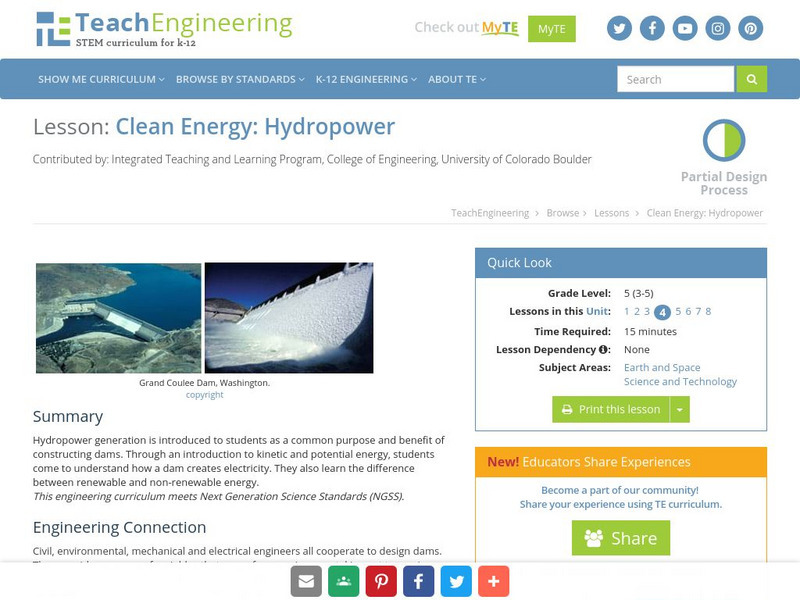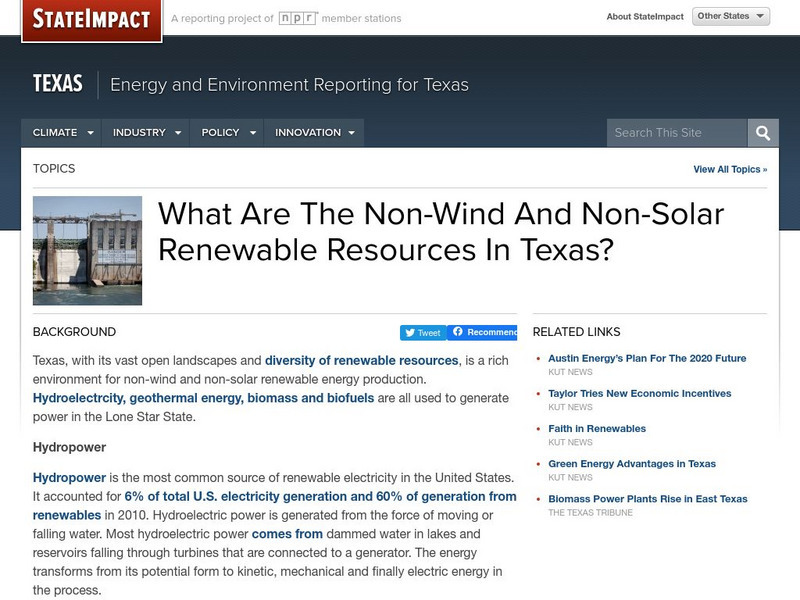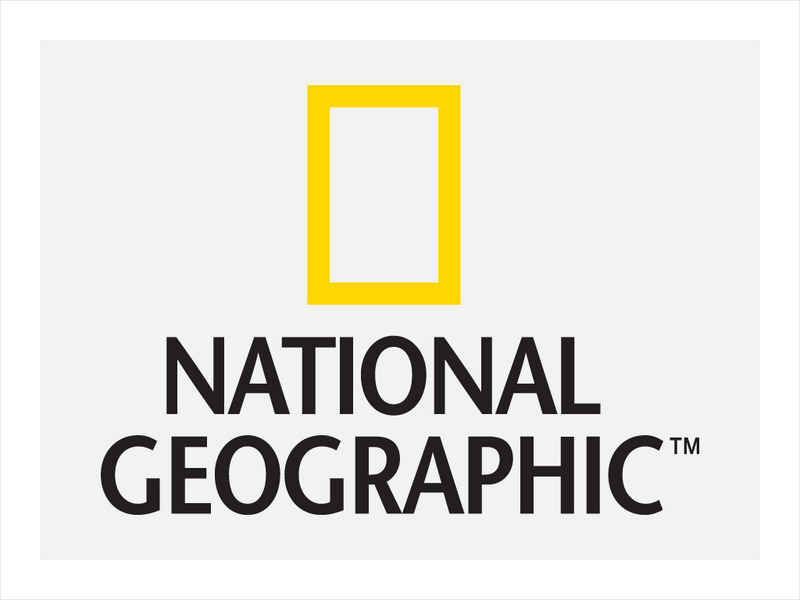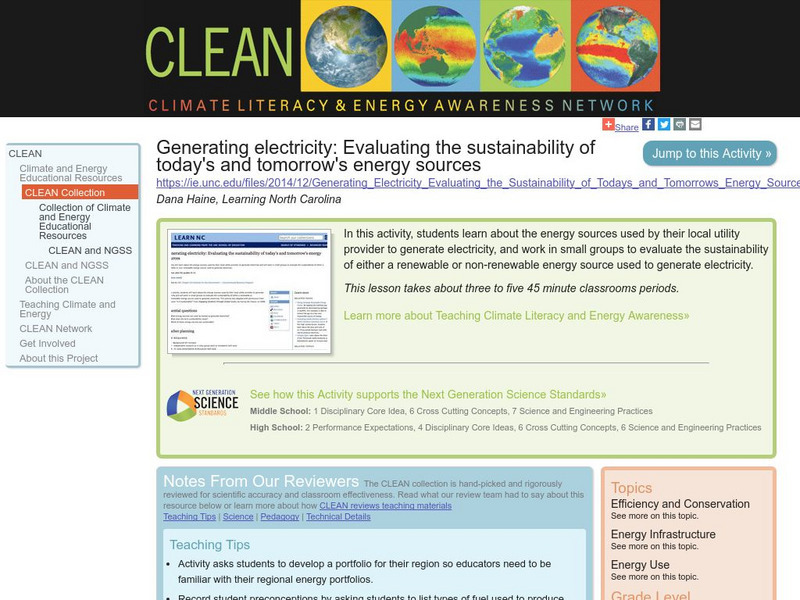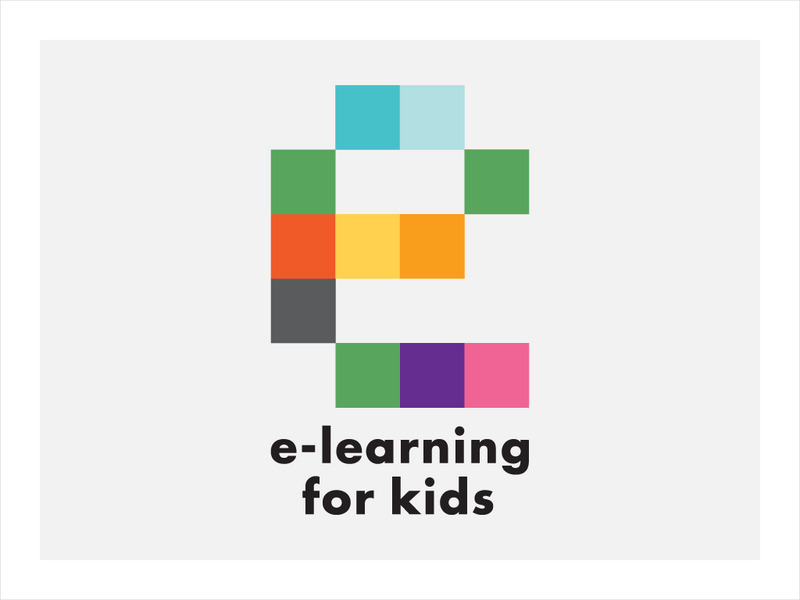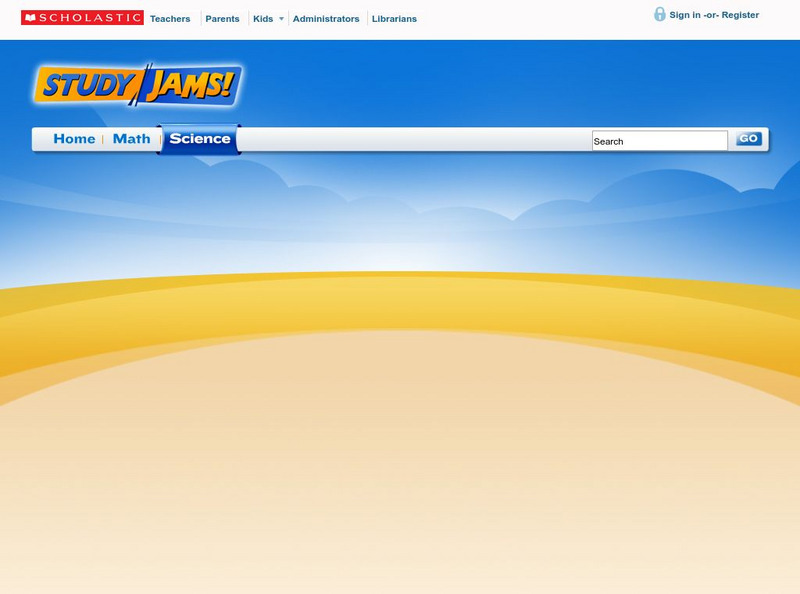TeachEngineering
Teach Engineering: Power Your House With Wind
Students learn how engineers harness the energy of the wind to produce power by following the engineering design process as they prototype two types of wind turbines and test to see which works best. Students also learn how engineers...
Energy4Me
Energy4me: Energy Sources of the World [Ppt]
Learn about the many different energy resources available from our Earth. Find out the pros and cons of each type: both renewable and nonrenewable.
US Energy Information Administration
U.s. Eia Energy Kids: Nonrenewable Energy Sources
This resource provides information about nonrenewable energy sources. There is specific information about each of these energy sources, and lots of maps, charts, tables, and graphs to further the understanding.
TeachEngineering
Teach Engineering: Clean Energy: Hydropower
Hydropower generation is introduced to students as a common purpose and benefit of constructing dams. Through an introduction to kinetic and potential energy, students come to understand how a dam creates electricity. They also learn the...
TeachEngineering
Teach Engineering: Energy Conservation
Students are introduced to the idea that energy use impacts the environment and our wallets. They discuss different types of renewable and nonrenewable energy sources, as well as the impacts of energy consumption. Through a series of...
E-learning for Kids
E Learning for Kids: Science: Cayman Islands: What Is Energy Conservation?
Renewable and nonrenewable energy sources are described, different types of energy, and how energy can be conserved.
Other
Lehigh University: Energy
An inquiry-based science unit for middle school students centered on the world's energy sources. The lessons integrate technology and lab activities while teaching about energy sources, production, and consumption.
NPR: National Public Radio
Npr: What Are the Non Wind and Non Solar Renewable Resources in Texas?
An overview of renewable energy resources in Texas, aside from wind and solar energy. Covers hydropower, geothermal energy, and biomass.
Other
Peak Oil: Non Renewable Resources Depletion Effects
A collection of graphs, tables, and diagrams that illustrate the global impact of natural resource depletion. (Published 2014)
BBC
Bbc: Gcse Bitesize: Energy Demands
Electricity is a very convenient form of energy that can be generated using different energy resources. Some of these resources are renewable and some are non-renewable. Each resource has advantages and disadvantages. A link to a test is...
US Department of Energy
Natural Gas: Fueling the Blue Flame
Natural gas is a colorless and odorless fossil fuel that is used in almost half the homes for heat. Learn more about this non-renewable energy resource.
NC State University
Ncsu: What Will Be Left of Earth's Non Renewable Resources?
An interactive graph that predicts how many years until more than two dozen natural resources (e.g., chromium, oil, tin, coal, etc.) are depleted, based on current production rates or production that grows each year. Use the slider at...
US Department of Energy
U.s. Department of Energy: Coal: Our Most Abundant Fuel
The U.S. has enough coal to last for the next 200-300 years. So why are we not using more of it? This article describes the different types or "ranks" of coal, the history, and the problems with burning coal for energy.
Council for Economic Education
Econ Ed Link: Be an Energy Saver
This lesson focuses on the scarce and non-renewable nature of fossil fuels in order to stimulate student thinking about energy conservation. It emphasizes the fact that saving energy can be good for the wallet as well as the earth's...
National Geographic
National Geographic: Energy Sources and Energy Use
A brief lesson where students identify energy sources that are renewable and nonrenewable, and discuss their own energy use.
Climate Literacy
Clean: Generating Electricity: Evaluating the Sustainability Energy Sources
In this activity, students learn about the energy sources used by their local utility provider to generate electricity and work in small groups to evaluate the sustainability of either a renewable or non-renewable resource used to...
Energy for Sustainable Development
Esd Bulgaria: Kids & Energy: Electricity
Electricity is the flow of electrical power or charge. It is a secondary energy source which means that we get it from the conversion of other sources of energy, like coal, natural gas, oil, nuclear power and other natural sources, which...
PBS
Pbs Teachers: Exploring Alternative Energy Sources
Calculate the increased cost of heating homes and fueling cars since the energy crisis. Investigate alternative renewable and nonrenewable energy sources that can be used to decrease Americans' dependency on fossil fuels.
TeachEngineering
Teach Engineering: Powering the u.s.
This lesson provides students with an overview of the electric power industry in the United States. Students also become familiar with the environmental impacts associated with a variety of energy sources.
Science4Fun
Science4 Fun: Energy
What is energy? Article provides a brief discussion of the many different forms of energy.
Science Education Resource Center at Carleton College
Serc: Powering the Future
This activity tests problem-solving skills while introducing a card exercise which allows students to solve real problems and make decisions about how best to provide electrical power to their country. Students must make choices between...
E-learning for Kids
E Learning for Kids: Scotland: What Is the Difference Between Renewable and Nonrenewable Resources?
Looks at types of natural resources that can be used for energy, and the difference between renewable and nonrenewable energy sources.
Scholastic
Scholastic: Study Jams! Science: Energy, Light and Sound: Natural Resources
A slideshow and a short quiz on natural resources, the difference between renewable and nonrenewable resources, and the impact humans have on the Earth's natural resources.
Scholastic
Scholastic: Study Jams! Science: Energy, Light and Sound: Fossil Fuels
A slideshow and a short quiz on the types of fossil fuels we use and the impact this has on the environment.



![Energy4me: Energy Sources of the World [Ppt] PPT Energy4me: Energy Sources of the World [Ppt] PPT](https://d15y2dacu3jp90.cloudfront.net/images/attachment_defaults/resource/large/FPO-knovation.png)

